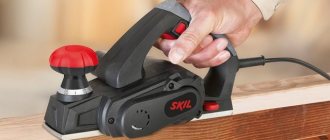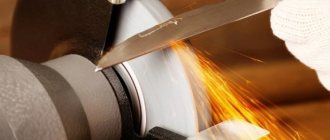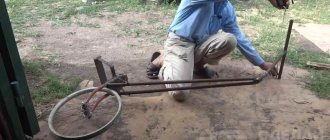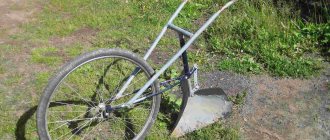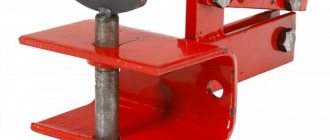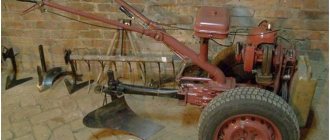How to choose and make an electric cultivator?
- 1 Types of cultivators
- 2 How to choose and use an electric cultivator?
- 3 How to make an electric cultivator?
An electric cultivator is an indispensable device for cultivating a summer cottage and loosening various types of soil. Despite all the positive features of this device, it is quite expensive, so before purchasing you should study the features of each type of cultivator.
Types of cultivators by type of working part: 1 - disk, 2 - milling, 3 - tine, 4 - rotary.
Simple cultivator "Tornado"
One of the simplest and cheapest cultivators to manufacture is the Tornado. It received this name due to the shape of the working part of the spiral-shaped sharp pins twisted in a spiral.
This design is designed to remove weeds along with the roots . To do this, four twisted pins are welded to the crosspiece at its ends perpendicular to the plane, and a pipe holder is welded to the middle at a right angle to the plane.
The length of the pipe is selected based on the ease of use of the tool and directly depends on the height of the person. A lever with equal arms relative to the center line of the pipe is attached to the end of the pipe to rotate the tool. The result should be something similar to a corkscrew, but much larger in size.
To make the working part of the cultivator - the teeth, you need to take a steel rod with a diameter of 10 mm and bend it half a turn on a bending machine with a distance equal to half the length.
Therefore, the rods must be selected up to 35 cm. After this, they must be bent in a certain way so that their maximum coincidence is achieved. The uniformity of the tool’s penetration into the ground and the quality of loosening depend on how accurately they are bent. Then they are welded to a cross made of a metal plate with a thickness of 4 mm and flat dimensions sufficient to secure the holding pipe.
The diameter of the pipe must be at least 20 cm to ensure the reliability of the structure. A handle-lever made of a pipe of the same diameter is attached to the upper part. aluminum pipes in order to significantly reduce the weight of the structure. The length of the lever must correspond to the width of the shoulders of the person who will carry out the processing with this tool. After this, you should sharpen the ends of the pins.
Typically, such a cultivator is made in the form of a hand tool , but it can be modified to create a more universal device that runs on electricity. To do this, the lever is made removable, and the pipe is telescopic with several height-mounted bolts. Then an adapter for the cartridge holder of an electric drill is made from a rod and pipe.
The main task is to maintain alignment relative to the axis so that there is no beating during operation, as well as the strength of fastening of all parts. After this, you need to choose a powerful drill with speed control and reverse, as well as a chuck for conventional drills. As a result, the cultivator will work like a regular drill attachment in the presence of electricity or manually when working in the field.
What materials are needed
Making a cultivator with your own hands for a tractor, mini-tractor or walk-behind tractor is extremely simple; all that matters is the desire and the necessary tools. For assembly you will need:
- compact grinder;
- metal discs;
- welding machine and electrodes for it;
- emery with two discs that have different abrasive values;
- drill and a set of various drills for it.
The materials from which the cultivator will be made are also required:
- metal square plates , the size of which depends on the specific model of the walk-behind tractor (usually 15x15 cm plates are sufficient);
- flat rectangular plates that will act as cutters. Their length and width also depend on the specific walk-behind tractor model. The optimal size is 25 cm in length and 4 cm in width;
- bolts and nuts in the amount of 16 pieces (in pairs);
- long tube made of durable steel.
After reading the following article, you will understand that to keep your garden area clean, you need a grass and twig shredder.
When selecting materials, it is important to consider the following factor: they must not only be very durable, but also resistant to corrosion.
This is important, since during cultivation, moisture will be present on the working surfaces, which is a strong oxidizing agent.
Once everything you need is prepared, you can begin assembly. Using a metal drill, make a hole in each square and rectangular plate.
Model based on a meat grinder engine
Much of what you need for work can be found on your farm or easily purchased. To manufacture structural elements you need:
- A serviceable engine from a meat grinder;
- Wheels with axles;
- Autospring;
- Corners;
- Scrap;
- Screw;
- 2 pipes.
There are also a lot of tools at hand:
- Sledgehammer;
- Pliers;
- A set of keys;
- Hammer;
- A welding machine, but if you don’t have one, you don’t need to buy it at all, but you can rent it.
2 corners are screwed to the gearbox made of metal, and then 2 pipes are welded to them, which will serve as handles, so they must first be bent to a shape that is convenient to use.
For strength, you can weld a metal spacer between the pipes. Next, axles for wheels are welded to the corners, which must be selected in medium sizes. Because small ones will get stuck in the ground, and large ones are inconvenient to control.
An ordinary crowbar is used as a shaft. The workpiece from it is installed in the sleeve, which remains after removing the meat grinder attachment. She removes it with a sledgehammer. Grousers are made from autosprings, which must be slightly screwed out during installation to make it easier to control the cultivator. They are then welded to the shaft at an angle of 120 degrees.
For ease of operation, a switch is attached to the handle, which is connected according to the “triangle” circuit; a capacitor electric start is used.
If you move the cultivator quickly, large clods of earth will remain, and if you move it slowly, the soil will be crushed. If desired, a homemade plow can also be made for it. Then it will be possible not only to loosen, but also to plow the soil. Such a homemade cultivator can last for quite a long time.
Option #4: a production meat grinder to help us
All of the above equipment is quite simple. But in your own workshop you can make a homemade electric cultivator. This once again proves that the possibilities of home craftsmen are almost limitless. To implement this idea, you will need an old industrial meat grinder. On its basis, an effective electric gardener’s assistant will be built.
An electric cultivator can be made on the basis of a meat grinder for industrial purposes: you get a fairly powerful unit that will last for several years
Everything is not as difficult as it seems if you have a welding machine and a master who knows how to use it for its intended purpose. Two corners should be attached to the gear housing. Bent pipes are welded to the corners, which will be used as handles. Another piece of pipe is welded between the resulting handles - a spacer, which gives the structure the required strength.
The axles for the cultivator wheels will also need to be welded to the corners. The wheels are selected to be of medium size so that they are easy to use and do not sink into the soil.
The main structural part is the shaft. It will have to be turned out of ordinary scrap. The connection is carried out as in the original: in a slot. The meat grinder attachment is chipped off with a sledgehammer, after which a bushing with thick walls made of cast iron remains. A blank machined from scrap is placed into it, to which lugs in the form of a screw are welded. They are cut from car springs. Other lug material options were used, but these proved to be unviable.
The lugs are located at an angle of 120 degrees. They need to be screwed out as they rotate, then it will be easier for them to enter the ground, and the cultivator itself will be easier to control. The engine of the device is connected according to the “triangle” circuit, the start is capacitor. For ease of operation, the engine switch is installed on the cultivator handle. The device will last a long time if, before starting work, you lubricate the mating of the homemade shaft in the cast iron bushing with any used oil.
How to make an electric cultivator with your own hands?
In order to enjoy all the benefits of mechanized labor, it is not at all necessary to purchase a walk-behind tractor.
Anyone who is more or less familiar with technology can make a useful device. To work you will need:
- working motor from a meat grinder;
- 2 pipes;
- corners;
- screw;
- wheels with axles;
- scrap.
- welding machine;
- pliers, sledgehammer, hammer;
- a set of keys.
Sequencing
- Screw 2 corners to the metal gear housing.
- Bend the ends of two tubes to obtain comfortable handles , weld the pipes to the corners.
- Weld to the corners of the axle for future wheels. When choosing transportation elements, keep in mind that wheels that are too large will not be easy to control , and that wheels that are too small may get stuck and fall into the ground. Therefore, these elements should be of medium size.
- Creating a structure shaft. Use a sledgehammer to break the meat grinder attachment. Place a scrap piece into the sleeve.
- Weld the grouser screw .
- An engine switch can be placed on one of the handles for more convenient use of the unit.
When moving quickly, such a cultivator will break the soil into large clods. With slow processing, the unit will help make the soil soft and loose, the work done will be neat.
reviews of electric cultivators say that these devices are becoming increasingly popular among summer residents, regardless of who the manufacturer of the unit is: a well-known company or self-assembly. The model is selected depending on operating conditions (soil type), volume and nature of work.
Troubleshooting a motor cultivator
Repairing a motor cultivator with your own hands is not difficult due to the simplicity of the equipment’s design. Let's look at the most common problems and methods for eliminating them:
- The cultivator motor does not start. This usually occurs due to lack of spark. You need to try replacing the spark plug. Another problem may be a lack of fuel supply due to clogged filters. They are disassembled, washed in gasoline, and then put back in place.
- The motor stalls during operation. The cause could again be spark plugs or poor fuel supply.
- An extraneous knock inside the engine indicates damage to one of the parts. The motor urgently needs to be disassembled to identify the malfunction, otherwise it will jam.
- A running engine makes a loud noise and overheats. The cause may be a poor fuel mixture or a suspended load while operating the cultivator. The equipment is allowed to cool, and during this time new fuel is prepared.
- The cultivator does not move. There may be something stuck between the cutters or wheels. Alternatively, the belt drive has become loose. If no such problems are detected, then the problem is in the gearbox.
The video talks about the renovation work:
Repairing a homemade motor-cultivator is easier to carry out, since all the components were assembled independently. You know what they are made of. It is better to entrust complex breakdowns of factory-made equipment to service center specialists.
Cultivator: purpose and characteristics of types
Cultivators are very convenient and popular agricultural tools used to perform surface loosening of the soil, as well as destroying weeds, applying fertilizers and cutting furrows for irrigation activities. When choosing a model of such equipment, you must be guided by the following basic parameters:
- relief features of the site;
- useful area of the site;
- qualitative composition and characteristics of the soil;
- scope and criteria of assigned tasks.
Depending on the purpose, there are several main types of agricultural cultivators:
- continuous tillage during pre-sowing tillage with simultaneous harrowing;
- inter-row tillage of the soil and simultaneous fertilizing of cultivated crops with basic mineral fertilizers;
- pre-sowing tillage, represented by loosening and layer-by-layer grinding of the soil, as well as the destruction of weeds, leveling and compacting the soil.
Equipment can also be classified depending on the operating mechanisms:
- electrical equipment used on small plots of land. Operation is ensured by electricity. The equipment is lightweight, compact in size and does not emit harmful substances into the environment. Disadvantages include low power and low mobility;
- battery equipment designed for soil treatment in small areas. The difference from electric models is sufficient mobility while maintaining small dimensions;
- Gasoline equipment is the most popular due to its high performance. Such units are quite powerful, mobile and convenient. The main disadvantages of the application are the emissions of harmful substances into the atmosphere, as well as the need to regularly perform competent maintenance.
User manual
For those household owners who purchased a LopLosh cultivator, the instruction manual will explain the main functions and method of carrying out cultivation and mulching work.
It consists of several points and sub-points that describe the purpose of the device: loosening the soil, forming furrows, hilling manure, processing turf, chopping weeds, cultivating between rows. Below are the technical data of the model for which the manual and delivery kit are provided, what is included in it.
The following are safety requirements when working with the device: avoid working with the device in the rain, use special clothing, and during setup and maintenance of the device, it is necessary to disconnect it from the network. When cultivating the soil, the power cable must be kept in a visible place and must always be in sight.
The next point is a description of the device, where all the main parts of the device are indicated, the sequence of their connections. Almost at the end of the instructions, the processes that can be performed using LopLosh and the procedure for preparing the product for their implementation are described:
- For loosening, left and right knives are installed on the shafts, and side walls are installed on the gearbox.
Knives
- The knives must be installed in such a way that their cutting part is directed in the direction of rotation. The walls are fastened in such a way that the fastening studs become in their seats; they need to be secured with nuts.
- The depth at which loosening will be carried out must be set by installing booms, above or below the knives.
- For mulching, it is enough to install a special knife on the high-speed shaft, and you need to install side walls on the gearbox.
- In order to form furrows with the help of LopLosh, you need to install several knives - the left and right row-crop knives are on the power shafts, and a hiller is installed on the gearbox, facing it.
In this video, the formation of beds using a LopLosh cultivator.
After the device is prepared for one of the operations, it is necessary to position it correctly on the treated soil. This process is described in the next paragraph of the instructions.
The main conditions are the installation of the device in the correct direction, with the handles in the direction of movement, and the placement of the power cable, which must be placed in rings on the leash.
Movement during tillage can be carried out at maximum speed, at which there are no signs of heavy load on the engine - it does not make extraneous noise and does not overheat.
How to make a cultivator
Every summer resident is well acquainted with all the difficulties of cultivating garden crops. And what is most tiring is tilling the soil before planting and during further care of garden plants. To make your life easier, all you need to do is make a homemade gasoline or electric cultivator for your garden, which will be used to solve various agricultural problems.
Before you begin assembly, you need to understand the types, structure and operating principle of garden tools.
Depending on the type of engine, electric and fuel cultivators are distinguished. The former are characterized by environmental friendliness and low energy consumption. However, they are tied to a source of electricity, so they can only be used in greenhouse conditions or in a small garden that has access to electricity. Making such a unit is quite simple.
Models with internal combustion engines are superior to the previous type in terms of power and the ability to work without connecting to an electrical outlet. But servicing the machine becomes more expensive, and harmful exhaust gases are released during operation.
According to the method of soil cultivation, homemade motor cultivators are either self-propelled, equipped with driven wheels, or with a rotating working attachment, which can be used as a means of movement.
The first option uses two gearboxes. The first helps the mechanism move at a given speed, and the second rotates the rotary attachment for cultivating the soil. If there are drive wheels, the cultivator is additionally equipped with flat-cutting knives.
There are also simplified homemade products, where the wheels only rest on the surface, making movement easier.
From the starter
If you have an unnecessary starter from a car in your home workshop, you can use it to create a primitive version of a motor cultivator. To do this, you need to shorten its shaft and slightly alter the front cover, making several holes in it with a diameter of up to 5 mm. This is necessary for the flow of air from the ventilation system. Then the prepared starter is combined into one unit with cutting elements (cutters).
The almost finished installation is fixed onto the working platform of the cultivator and checked for functionality. You can make an electric cultivator with your own hands from a starter in a couple of hours and with minimal financial costs.
From the Bulgarian
The homemade version of a mini-cultivator made from a grinder is not very productive, but it perfectly solves the problem of weeding a small area with light soil. The grinder in this homemade invention plays the role of an electric drive. The remaining components and parts can be taken from an old non-working cultivator.
A grinder is attached to a frame created from improvised means or taken from an old frame, as well as an extension cord on a reel for connecting to a source of electricity.
After assembling the main elements, you can test the machine. If everything is done correctly, the cutters will produce up to 300 rpm.
From the washing machine
Craftsmen make a cultivating device from an old, unnecessary washing machine, which still works, but can no longer be used for its main task - washing. The engine must be removed from old equipment. It will serve as the basis for a future cultivator and give the washing machine a second life.
In addition to the power plant, you will have to find a two-core wire, a gearbox, a three-meter metal corner, switches, car springs, a start button and a drum with a piece of tin.
Having prepared the necessary elements, you can proceed to installation work. Initially, welding is carried out, and then the cutting elements are prepared. It is important to ensure that each knife does not overlap with any other.
The starting and working windings are connected to the motor itself. The first is needed only to start the device, and the second is used all the time.
After completing the above steps, you can begin testing the device.
From an old bicycle
An equally interesting homemade product is a manual cultivator made from a bicycle. To make such a device, you need to prepare a metal pipe, frame and bicycle wheel. You will also need metal blanks, steel strips, a drill, an angle grinder and a cultivator head.
Installation work consists of the following stages:
- The cultivator head is attached to the bicycle frame. The crossbar and handles are made from a metal pipe. They are connected using bolts.
- Next comes the locknuts. They will be needed to secure the wheel to the frame.
- After completing these steps, the mechanism can be considered ready. A plow and related accessories can be attached to such a cultivator, which will make it more functional.
From a chainsaw
You can create a motorized cultivator with your own hands from a chainsaw. A powerful chainsaw of domestic or foreign production is used as the basis. It is advisable to take the “Friendship” model, because... it is cheaper than imported devices and has the required characteristics.
The garden assistant based on “Friendship” accelerates to 2.5 km/h and the power value is 4 hp. With.
The step-by-step assembly guide is as follows:
- The main halyard is equipped with a collar flange. This is necessary for the subsequent connection of bridge gearboxes.
- Next, sprockets are taken (can be from an old UAZ) and a double-row chain. Parts are needed to raise the distance from the geared axle to the ground. Timing sprockets can increase the distance by 15 cm.
- Housing bearings and a gearbox are installed on the key bridge.
- To fix the cutting elements, you need to use a steel pipe. In this case, it is important to ensure that the direction of the cutters corresponds to the movement of the walk-behind tractor.
- After completing the assembly work, a load is attached to the frame that can maintain the center of gravity.
- For convenient control of the unit, it is equipped with handles.
Manufacturing an electric cultivator using a st-8 starter from gaz-51
Structure of a cultivator engine (ST-8 starter with an electric fan in one casing) An electric cultivator can be made at home using an ST-8 starter from a GAZ-51 engine.
To use the starter in the cultivator device, it will need to be upgraded. For this purpose, you need to shorten the starter shaft slightly. A new front cover is machined from D16TV duralumin alloy and a ball bearing 204 is pressed into it.
The standard bronze bearing is left in the rear cover, but to improve lubrication, a cap-type oiler with lithol is installed on it. A large number of holes with a diameter of 5 mm are drilled in both covers for ventilation. Air is driven through these holes using a fan, the impeller of which is placed on the shaft of the ME-7B electric motor used on the ZIL-164 truck.
A drive sprocket from a K-125 motorcycle is installed on the starter shaft shank, which is preliminarily mated to the hub hub. The sprocket has a bush-roller chain connection with the driven sprocket, with the same parameters installed on the input shaft of the gearbox.
Two sprockets with 11 teeth and a pitch of 15.875 mm are installed on the output shaft of the gearbox and two of the same are mounted on the working shaft. These sprockets are connected using bushing-roller chains. To tension the chains, you can use bushings for the gearbox. The casing protects the chain from contamination.
Cultivator cutters are installed at the ends of the working shaft.
Toothed hand cultivator
To make a gear cultivator, more effort and skills will be required, but if you really want to, it is also quite simple to make; it had steel plates and a pin, as well as teeth and an axle.
Steel pancakes are put on an axle of a certain diameter (it is necessary to make calculations in advance regarding the severity and compatibility of the weight of both. The pancakes should already have holes into which teeth made of steel rods or spring steel are inserted. They are secured with rivets, which are subsequently unlinked.
Although this is far from the only option that has been invented by savvy summer residents.
Manufacturing technology
From forks of the “Tornado” type
It has the simplest design, somewhat reminiscent of a corkscrew. Consists of a vertical stand and a horizontal handle. You can safely make such a cultivator yourself using a regular pitchfork.
To do this, you will need a plastic attachment, which is usually used for forks, shovels, in the shape of a handle. We slightly modify the nozzle so that the handle looks like a horizontal pipe. For it, take a piece of plastic pipe measuring 0.5 m.
- A cut is made along the pipe so that when turned out, it fits onto the handle.
- For reliability of the coupling and further practical use, secure everything with electrical tape.
- All that remains is to twist the forks into a corkscrew shape. To do this, bend the teeth in the desired direction with a hammer.
Types of cultivators
This equipment is available in different models:
- disk
- paws
- rotary
- milling
Almost all cultivators work on the same principle: the mechanical part is started, which sets the device in motion, loosening the soil.
Diagram of a manual cultivator (click on the photo to enlarge)
Its classification depends on the purpose of the equipment: differences in size, engine power, operation, scope of work. Considering these criteria, they are:
- light
- moderate severity
- heavy.
For relatively small areas with soft soil, light equipment is suitable, usually flower beds and greenhouses. Medium-weight equipment is designed for clay soil. Heavy equipment is universal, it is suitable for any type of soil.
Cultivators differ in the way they function:
- hand cultivators;
- with electric drive;
- on gasoline.
We will focus on manual cultivators, which you can make yourself to save money.
A number of advantages of manual designs:
- They are economical and do not require refueling.
- Several devices are replaced: a shovel, a hoe, a rake.
- They take up little space.
- Help distribute the load across all muscles.
Our next article tells us what is better to use in the country: a walk-behind tractor or a cultivator.
Additional recommendations
If, after reading the step-by-step instructions, you decide to make such a cultivator yourself, then you must not forget about safety measures. First of all, it is necessary to protect your eyes and hands, especially when working with a welding machine.
If arc welding is used during work, then you need to protect yourself not only from the intense and very bright light emitted by the device, but also from scale, which, having appeared at the site of the weld, can break off from the metal and fly high.
Personal protective equipment when performing welding work
Personal protective equipment when performing welding work Ten rules of welding work
When using gas welding, when heating metal, be sure to wear protective gloves and use special face protection. You work with high temperatures, so your skin needs to be protected from burns. The remarkable thing about hand cultivators is that they can be made even without special skills or experience.
Making a homemade cultivator is not as difficult as it might seem
DIY electric cultivator
An electric tool can be made from scrap materials in 2 days, but you need to prepare in advance.
Electric cultivator device
To assemble it you may need: a motor from a washing machine, a gearbox, sprockets and a chain from a children’s bicycle, bearings, cultivator blades welded from car springs, angles, wheels, a cable about 50 m long, a piece of tin to protect the motor from the soil . Instead of a washing machine engine, you can use a powerful Soviet drill, plus a gearbox from a burnt grinder, or an electric meat grinder.
A structure assembled from one or another of the proposed elements will look something like this: a metal frame with two wheels on both sides. The motor from a washing machine, meat grinder or drill is in the center. It needs to be connected to the cultivator blades and ensure rotation using a chain and “sprockets” from a children’s bicycle.
DIY electric cultivator
On two handles you can attach a cable with a trigger mechanism.
Advice. The sharpened parts of the knives must be positioned on the side of rotation of the shaft. The blades should be 5 cm apart, at an angle of 120°.
- First, the main parts are made and fastened, then a frame is made for them. The dimensions depend on the available materials you use.
- A gearbox with a transmission mechanism is welded to the engine housing.
- Blades are attached to the output shaft of the gearbox. You can use sharpened and fastened car springs or any other metal.
- The engine is attached to a frame made of angles with clamps and bolts.
- There should be an axle along the central axis with wheels on the sides.
- Handles and cable are welded on top.
Homemade electric cultivator from a chainsaw
- lightweight and convenient electrical design;
- environmentally friendly, unlike gasoline-powered mechanisms. This means that it can be used in greenhouses and greenhouses.
- welding must be used during manufacturing;
- not suitable for processing large areas.
Mechanical improvements not only make labor easier, but also increase the efficiency and speed of tillage. Any of the considered farmer's tools is indispensable when working on the land and is easy to use.
Adjusting the device
Setting up the unit with your own hands can be done either in conjunction with a tractor or separately, on a designated area.
- To regulate the reverse gear, use shims of a size corresponding to the depth of the area, reduced by the value of the wheel recess.
- The frame is implemented using working parts parallel to the surface so that each individual paw is located on it.
To work with soil more than 8 cm deep and for difficult surfaces, the paws are tilted downward at an angle of 2-3 degrees, equal to the distance between the rear paw ring and the surface.
- Frame adjustment is tested by the clearance from the platform to the beams at skewed angles. The gap should be as shown in the photo.

